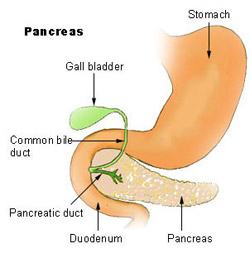Pancreas
The pancreas is a long, soft organ that lies in the abdomen that plays an important role in both the endocrine system and digestion.

Anatomy[edit]
The pancreas lies transversely along the posterior abdominal wall, posterior to the stomach, and extends from the region of the duodenum to the spleen.
Etiology[edit]
The word pancreas is from the Greek πᾶν (pân, “all”) & κρέας (kréas, “flesh”).
Structure[edit]
The pancreas is an intra-abdominal organ that in humans lies in the abdomen, stretching from behind the stomach to the left upper abdomen near the spleen.

Parts of pancreas[edit]
Anatomically, the pancreas is divided into a head, neck, body, and tail. The pancreas stretches from the inner curvature of the duodenum, where the head surrounds two blood vessels: the superior mesenteric artery, and vein.
Blood supply[edit]
The pancreas has a rich blood supply, with vessels originating as branches of both the coeliac artery and superior mesenteric artery.
The body and neck of the pancreas drain into the splenic vein, which sits behind the pancreas and the head drains into, and wraps around, the superior mesenteric and portal veins, via the pancreaticoduodenal veins.
The lymphatic vessels of the body and tail drain into splenic lymph nodes, and eventually into lymph nodes that lie in front of the aorta, between the coeliac and superior mesenteric arteries. The lymphatic vessels of the head and neck drain into intermediate lymphatic vessels around the pancreaticoduodenal, mesenteric and hepatic arteries, and from there into the lymph nodes that lie in front of the aorta.
Inflammation of the pancreas is known as pancreatitis, with common causes including chronic alcohol use and gallstones. Because of its role in the regulation of blood sugar, the pancreas is also a key organ in diabetes mellitus. Pancreatic cancer can arise following chronic pancreatitis or due to other reasons, and carries a very poor prognosis, as it is often identified when it has spread to other areas of the body.
Function[edit]
Pancreas is one of very few organs in the body that has both endocrine and exocrine functions.

Exocrine fuction[edit]
The pancreas has an exocrine portion that secretes digestive enzymes that are carried through a duct called pancreatic duct to the duodenum.
Endocrine function[edit]
The endocrine portion consists of the pancreatic islets, which secrete glucagons and insulin.
- The alpha cells in the pancreatic islets secrete the hormone glucagon in response to a low concentration of glucose in the blood.
- Beta cells in the pancreatic islets, called islets of Langerhans, secrete the hormone insulin in response to a high concentration of glucose in the blood.
Pancreatic disorders[edit]


| Anatomy of the liver, pancreas and biliary tree | ||||||
|---|---|---|---|---|---|---|
|
Ad. Transform your life with W8MD's Budget GLP-1 injections from $75


W8MD offers a medical weight loss program to lose weight in Philadelphia. Our physician-supervised medical weight loss provides:
- Weight loss injections in NYC (generic and brand names):
- Zepbound / Mounjaro, Wegovy / Ozempic, Saxenda
- Most insurances accepted or discounted self-pay rates. We will obtain insurance prior authorizations if needed.
- Generic GLP1 weight loss injections from $75 for the starting dose.
- Also offer prescription weight loss medications including Phentermine, Qsymia, Diethylpropion, Contrave etc.
NYC weight loss doctor appointmentsNYC weight loss doctor appointments
Start your NYC weight loss journey today at our NYC medical weight loss and Philadelphia medical weight loss clinics.
- Call 718-946-5500 to lose weight in NYC or for medical weight loss in Philadelphia 215-676-2334.
- Tags:NYC medical weight loss, Philadelphia lose weight Zepbound NYC, Budget GLP1 weight loss injections, Wegovy Philadelphia, Wegovy NYC, Philadelphia medical weight loss, Brookly weight loss and Wegovy NYC
|
WikiMD's Wellness Encyclopedia |
| Let Food Be Thy Medicine Medicine Thy Food - Hippocrates |
Medical Disclaimer: WikiMD is not a substitute for professional medical advice. The information on WikiMD is provided as an information resource only, may be incorrect, outdated or misleading, and is not to be used or relied on for any diagnostic or treatment purposes. Please consult your health care provider before making any healthcare decisions or for guidance about a specific medical condition. WikiMD expressly disclaims responsibility, and shall have no liability, for any damages, loss, injury, or liability whatsoever suffered as a result of your reliance on the information contained in this site. By visiting this site you agree to the foregoing terms and conditions, which may from time to time be changed or supplemented by WikiMD. If you do not agree to the foregoing terms and conditions, you should not enter or use this site. See full disclaimer.
Credits:Most images are courtesy of Wikimedia commons, and templates, categories Wikipedia, licensed under CC BY SA or similar.
Translate this page: - East Asian
中文,
日本,
한국어,
South Asian
हिन्दी,
தமிழ்,
తెలుగు,
Urdu,
ಕನ್ನಡ,
Southeast Asian
Indonesian,
Vietnamese,
Thai,
မြန်မာဘာသာ,
বাংলা
European
español,
Deutsch,
français,
Greek,
português do Brasil,
polski,
română,
русский,
Nederlands,
norsk,
svenska,
suomi,
Italian
Middle Eastern & African
عربى,
Turkish,
Persian,
Hebrew,
Afrikaans,
isiZulu,
Kiswahili,
Other
Bulgarian,
Hungarian,
Czech,
Swedish,
മലയാളം,
मराठी,
ਪੰਜਾਬੀ,
ગુજરાતી,
Portuguese,
Ukrainian


